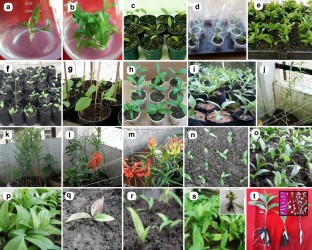Optimization of growing conditions, substrate-types and their concentrations for acclimatization and post-acclimatization growth of in vitro-raised flame lily (Gloriosa superba L.) plantlets
Research Articles | Published: 04 October, 2021
Online ISSN : 2229-4473.
Website:www.vegetosindia.org
Pub Email: contact@vegetosindia.org
First Page: 228
Last Page: 236
Views: 1029
Keywords:
Colchicine, Field transfer, Potting mixture, Survival, Transplantation
Abstract
Majority of tissue culture-raised flame lily (Gloriosa superba L.) plantlets do not thrive following their transfer from in vitro conditions to in vivo field conditions. Such plantlets need to be acclimatized with high survival rate in order to ensure the availability of quality planting materials so that supply of colchicine can be sustained. In this study, various factors viz. different tenures of acclimatization (2 weeks, 3–6 weeks, 7–10 weeks, 11–14 weeks, and 14 weeks), and different potting mixtures [such as (a) sterilized vermiculite + sterilized soil at culture room; (b) garden soil : sand : vermiculite; 2:1:1 under shade in net-house (SNH); (c) garden soil : sand : farmyard manure; 2:1:1 potted plants in direct sun light (DSL); (d) garden soil : sand : farmyard manure; 2:1:1 potted plants in DSL; (e) field-transferred plantlets after 3rd week in experimental field/home garden under DSL] were optimized to obtain maximum growth responses during in vivo acclimatization of G. superba. Amongst all the tested growth parameters, the SNH (b) condition was found to be the most suitable in terms of survival rate (100 %), followed by 60.71 % in natural habitat (a, c–e). In contrast, plantlet height (~ 146 cm) and number of shoot/plantlet (~ 14) were highest in natural habitat (a, c–e) followed by SNH (b) condition that exhibited lower plantlets height (~ 10 cm) and less number of shoots/plantlet (~ 3). Present study reports a successful acclimatization protocol for this medicinal herb to ensure its maximum in vivo survival eventually to meet the demand of large-scale quality propagules as a sustainable source of colchicine.

(*Only SPR Members can get full access. Click Here to Apply and get access)
References
Amutha R, Jawahar M, Paul SR (2008) Plant regeneration and in vitro flowering from shoot tip of Basilicum polystachyon (L.) Moench—an important medicinal plant. J Agric Technol 4:117–123
Balamurugan V, Amal TC, Karthika P, Selvakumar S, Vasanth K (2019) Somatic embryogenesis and plant regeneration in Gloriosa superba L.: an endangered medicinal plant. In: Kumar M, Muthusamy A, Kumar V, Bhalla-Sarin N (eds) In vitro plant breeding towards novel agronomic traits. Springer, Singapore, pp 27–42
Chaari-Rkhis A, Maalej M, Chelli-Chaabouni A, Fki L, Drira N (2015) Photosynthesis parameters during acclimatization of in vitro-grown olive plantlets. Photosynthetica 53:613–616
Chandra S, Bandopadhyay R, Kumar V, Chandra R (2010) Acclimatization of tissue cultured plantlets: from laboratory to land. Biotechnol Lett 32:1199–1205
Gantait S, Mandal N, Das PK (2011) In vitro accelerated mass propagation and ex vitro evaluation of Aloe vera L. with aloin content and superoxide dismutase activity. Nat Prod Res 25:1370–1378
Gopinath K, Karthika V, Gowri S, Arumugam A (2014) In vitro morphogenetic regeneration from root explant of Gloriosa superba L. for enhanced crop production. Sci Tech J 1:27–30
Hao G, Du X, Zhao F (2010) Fungal endophytes-induced abscisic acid is required for flavonoid accumulation in suspension cells of Ginkgo biloba. Biotechnol Lett 32:305–314
Kudikala H, Jogam P, Sirikonda A, Mood K, Allini VR (2020) In vitro micropropagation and genetic fidelity studies using SCoT and ISSR primers in Annona reticulata L.: an important medicinal plant. Vegetos 33:446–457
Kumar CN, Jadhav SK, Tiwari KL, Afaque Q (2015) In vitro tuberization and colchicine content analysis of Gloriosa superba L. Biotechnol 14:142–147
Mahajan R, Kapoor N, Billowria P (2016) Callus proliferation and in vitro organogenesis of Gloriosa superba: an endangered medicinal plant. Ann Plant Sci 5:1466–1471
Mahendran D, Kavi Kishor PB, Sreeramanan S, Venkatachalam P (2018) Enhanced biosynthesis of colchicine and thiocolchicoside contents in cell suspension cultures of Gloriosa superba L. exposed to ethylene inhibitor and elicitors. Ind Crop Prod 120:123–130
Mukherjee E, Gantait S, Kundu S, Sarkar S, Bhattacharyya S (2019) Biotechnological interventions on the genus Rauvolfia: recent trends and imminent prospects. Appl Microbiol Biotechnol 103:7325–7354
Murashige T, Skoog F (1962) A revised medium for rapid growth and bioassays with tobacco tissue cultures. Physiol Plant 15:473–497
Nithya P, Arockiasamy DI (2006) In vitro mass multiplication of Datura metal L. from root explants. J Swamy Bot Club 23:131–134
Panigrahi J, Gantait S, Patel IC (2017) In vitro regeneration of Chlorophytum borivilianum Santapau and RR Fern. Med Plants 9:76–79
Patel AI, Desai BS, Chaudhari BN, Vashi JM (2020) Genetic improvement in glory lily (Gloriosa superba L.): a review. Int J Chem Stud 8:255–260
Pospóšilová J, Tichá I, Kadleček P, Haisel D, Plzáková Š (1999) Acclimatization of micropropagated plants to ex vitro conditions. Biol Plant 42:481–497
Singh D, Mishra M, Yadav AS (2015) Study the effect of growth regulators on micropropagation of Gloriosa superba L. from seeds and their acclimatization. Ann Res Rev Biol 29:84–90
Sivakumar S, Siva G, Sathish S, Kumar GP, Vigneswaran M, Vinoth S, Kumar TS, Sathishkumar R, Jayabalan N (2019) Influence of exogenous polyamines and plant growth regulators on high frequency in vitro mass propagation of Gloriosa superba L. and its colchicine content. Biocatal Agric Biotechnol 18:101030
Subiramani S, Sundararajan S, Govindarajan S, Sadasivam V, Ganesan PK, Packiaraj G, Manickam V, Thiruppathi SK, Ramalingam S, Narayanasamy J (2019) Optimized in vitro micro-tuber production for colchicine biosynthesis in Gloriosa superba L. and its anti-microbial activity against Candida albicans. Plant Cell Tiss Organ Cult 139:177–190
Acknowledgements
Author Information
Crop Research Unit (Genetics and Plant Breeding), Bidhan Chandra Krishi Viswavidyalaya, Nadia, India
saikatgantait@yahoo.com
Plant Tissue Culture Laboratory, Institute of Biological Science, Kailod Kartal, SAGE University, Indore, India
sandeep.20j@gmail.com